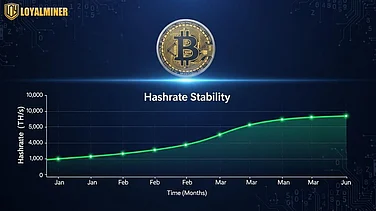Algorithmic stablecoins have been among the most debated innovations in the crypto world. The basic concept contrasts with classic stablecoins, where value is derived from reserves in fiat money, in that algorithmic stablecoins use smart contracts to back the value through supply adjustments and create market incentives. The promise is huge: fully decentralized digital money without dependence on banks or custodians. It's a rather new innovation, carrying a number of risks, controversial failures, and ongoing discussion around global regulation, such as the England Stablecoin Cap.
What are algorithmic stablecoins?
Algorithmic stablecoins include those types of cryptocurrencies that try to maintain stability at $1 through algorithms, instead of physical reserves. They depend on:
Smart contracts
Automating supply expansion and contraction
Incentivized Tokenomics
Market arbitrage
Unlike other fiat-backed stablecoins, like USDC or USDT, algorithmic stablecoins don't hold dollars in a bank: the blockchain system itself is supposed to keep the price stable.
How is stability achieved in algorithmic stablecoins?
1. Supply and Demand Changes
Supply is topped up by minting new tokens when the price of the stablecoin goes above $1.
Burning tokens decreases supply when it is below the $1 mark.
2. Dual-Token Models
Most algorithmic stablecoins rely on two tokens:
Stablecoin: the cryptocurrency whose job it is to maintain the peg stable.
Volatility token: absorbs the price shocks
Examples include Terra's UST and LUNA, though this system famously collapsed in 2022.
3. Arbitrage Opportunities
Traders also help to stabilize the peg by exploiting price differences:
Buy low, redeem high
Sell high, mint low
Theoretically, it makes the system at least partially self-regulating.
Types of Algorithmic Stablecoins
1. Rebase Models
In other words, the supply of tokens varies in fixed intervals according to the current market price.
Example: AMPL Ampleforth
2. Seigniorage Shares Models
Any two or more tokens can collaborate and remain stable.
Example: Basis Cash (experimental)
3. Fractional Algo Models
Partly algorithmic and part collateral-backed.
Example: FRAX - Fractional Stablecoin Model
Why Algorithmic Stablecoins Matter
Algorithmic stablecoins promise that
Full Decentralization
Increased access
Elimination of custody risks
Scalability without any reservation limitations
Without appropriate regulation and strong design, however, they are prone to instability.
That is among the many reasons various regulators around the world, including those in England, check on such arrangements for consumer protection, like the England Stablecoin Cap.
Challenges and Risks of Algorithmic Stablecoins
Despite such promising potential, a host of difficulties stand in the way of algorithmic stablecoins, at least for now:
1. High Volatility
If market confidence falls, the stablecoin will spiral downwards.
2. Death Spirals (UST Example)
A sudden selloff can bring down the entire ecosystem.
3. Complexity
Most users do not understand mechanisms and therefore are more vulnerable to risks.
4. No Collateral
This makes it difficult to recover from any sudden market shock due to a lack of physical reserves.
5. Regulatory Issues
Most of the countries are concerned about transparency and consumer risks and have issued regulations: for instance, England has a cap on Stablecoin issuance, market size, or other systemic risk factors.
England Stablecoin Cap: Why It Matters for Algorithmic Stablecoins
As has often been discussed within the digital asset ecosystem, the England Stablecoin Cap has become a talking point in its own right. That said, even while the frameworks do continue to change, it is a regulatory limit on the issuance or market size of stablecoins, and its objective is:
Limit excessive risk to the financial system
Protecting consumers from unstable or unbacked assets
Encourage responsible innovation
Prevent systemic failures such as the fall of Terra.
The Stablecoin Cap for England means going fully decentralized is just not enough; it needs to be stable and safe, too.
Regulators strike a balance: they allow innovation while forestalling catastrophic economic outcomes.
Benefits of Regulation of Algorithmic Stablecoins
A framework such as the England Stablecoin Cap has the potential to ensure that Transparency of token mechanisms Improving risk assessments Controls on rapid supply expansion Improved market confidence Protection against unstable or fraudulent stablecoins Ultimately, safe regulation can improve the long-run viability of algorithmic stablecoins.
Future of Algorithmic Stablecoins
There are a number of ways in which algorithmic stablecoins could be developed:
1. Hybrid Models Perhaps a combination of both collaterals and algorithms will be involved in the future of financial lending.
2. Smarter Smart Contracts AI-driven risk modeling can reduce instability.
3. Integration with Central Bank Digital Currencies (CBDCs) Stablecoins could complement CBDCs, such as the digital pound.
4. Stricter International Regulations On a global level, the development and implementation of frameworks similar to the England Stablecoin Cap may be seen.
5. Institutional Adoption With risks managed, banks and financial institutions can enter the algorithmic stablecoin space.
FAQs
1. Are algorithmic stablecoins safe?
Not always, since that depends on its design, liquidity, and market confidence. Failures like UST have shown the risks associated.
2. How does the England Stablecoin Cap impact algorithmic stablecoins?
The England Stablecoin Cap sets forth guidelines for stability, transparency, and consumer protection, with specific concern for unbacked stablecoins.
3. Do algorithmic stablecoins require collateral?
Some do; some don't. While fully algorithmic models depend upon supply-demand mechanics only, hybrid models use partial collateral.
4. Can algorithmic stablecoins ever replace traditional stablecoins?
They can, sometime in the future, but technology needs to mature and be more secure before large-scale adoption.
5. Why do algorithmic stablecoins collapse?
Most of the collapses happen when confidence drops, leading to panic selling. This triggers a supply-demand imbalance that results in a “death spiral.”





















